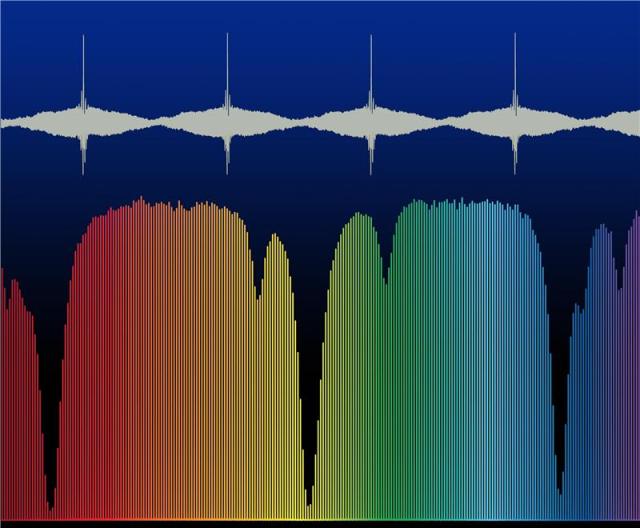Dec 24 2015
Electro-optic modulators, which can switch light on and off within just picoseconds, are enabling ever faster telecommunication over optical glass fibres, so that large movies can be streamed more smoothly across oceans into our homes.
The same tools have now been harnessed for high-speed and accurate molecular sensing, as reported by an international collaboration around Dr. Nathalie Picqué, Max Planck Institute of Quantum Optics and Ludwig-Maximilians-Universität Munich, in a letter published in Nature Photonics, 21 December 2015. The collaboration partners are with the Laboratoire Interdisciplinaire Carnot de Bourgogne (France) and the Institut des Sciences Moléculaires d’Orsay (France).
 Time-domain interference signal of the beats between the two frequency-agile laser combs and part of the resulting spectrum of the CO2 molecule. (Graphic: MPQ, Laser Spectroscopy Division)
Time-domain interference signal of the beats between the two frequency-agile laser combs and part of the resulting spectrum of the CO2 molecule. (Graphic: MPQ, Laser Spectroscopy Division)
Molecules absorb light at well-defined particular colours or optical frequencies. Usually such characteristic frequencies are located in the infrared region of the electromagnetic spectrum. Precisely measuring a set of such absorption dips unambiguously identifies the molecules and quantifies their abundance in the probed environment. Because detection of molecules by optical absorption spectroscopy is sensitive and nonintrusive, it finds an increasing number of applications, from biomedical diagnostics to atmospheric sensing. In the gas phase, the absorption lines are narrow so that high spectral resolution is needed to distinguish the different lines. Although many powerful spectroscopic techniques have been developed, rapid and precise high-resolution sensing is still a challenge.
A team of scientists at MPQ reports a promising new technique of near-infrared spectroscopy. They use modulators and a nonlinear optical fibre to produce two frequency combs, each with more than a thousand evenly spaced infrared spectral lines with a remarkably flat intensity distribution. Line spacing and spectral position can be selected quickly and freely by simply dialing a knob. Such frequency-agile optical combs offer unprecedented freedom when interrogating a molecular spectrum via a powerful technique called multiplexed dual-comb spectroscopy. Two mutually coherent combs are combined in an interferometer. Unprecedented refresh rates (80 kHz) and tuning speeds (10 nm s-1) at high signal-to-noise ratio are achieved. Such unique combination holds much promise for trace gas sensing, a domain relevant to physics, biology, chemistry, industry or atmospheric sciences. “Furthermore, the frequency-agile frequency comb generator might also become an enabling tool for applications beyond spectroscopy, like for arbitrary waveform generation, radio-frequency photonics, optical coherence tomography or microscopy”, concludes Dr. Ming Yan, a post-doc working at the experiment.